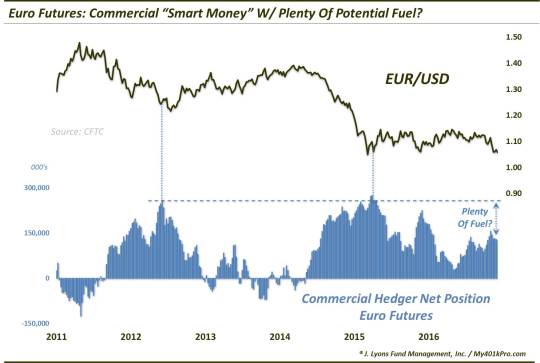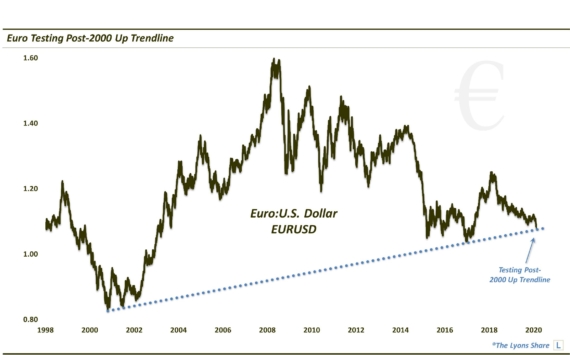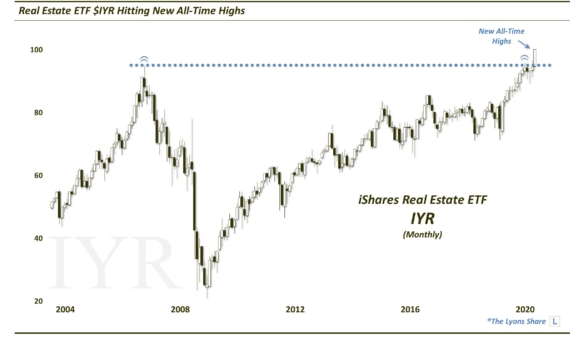Euro Going To Parity Like It’s 1999

For the first time since the year of its inception, the Euro appears likely to drop down to 1.00 vs. the U.S. Dollar.
Everyone is talking about the strength of the U.S. Dollar Index (DXY) so we thought we’d look at the flip side of it in today’s Chart Of The Day. While the DXY is measured against a basket of 6 other currencies, fully 57% of that basket is weighted toward the Euro. Thus, much of the movement of the DXY
inversely
reflects the movement of the Euro. And while we are hardly the only ones to note yesterday’s 14-year low in the Euro currency versus the Dollar, it is a pretty big deal. Plus, we just had to write that headline.
The Euro was officially introduced as a currency in January 1999 at 1.17 versus the Dollar. It subsequently began dropping, eventually reaching parity versus the Dollar (i.e., 1.00) in December of that year. It would spend essentially the next 3 years below parity, making its lifetime low at 0.82 in October 2000. In December 2002, the Euro would rise above parity for for good. So, the Euro has been at parity more recently than 1999 – but technically, that was the last and only time it dropped down there from above.
The Euro would reach a high of 1.60 in 2008.
Since then, it has been in a steady downtrend. This downtrend has brought the Euro down near the 1.05 range on 3 occasions in the past 2 years, March and November of 2015 and November of this year. As avid chart followers, we are keenly aware of how reliable triple tops and bottoms are, i.e., they aren’t. Thus, yesterday’s drop below those prior lows and into the 1.03 range was not a surprise. Another tipoff to this move to 14-year lows came during last month’s plunge. That’s because, in the process, the Euro broke below its lifetime Up trendline stemming back to its 2000 lows and connecting the 2001 lows and the 2 lows from last year. That break portended this move to fresh lows.

So what’s next? With parity merely 4 cents away from current prices, that is not a tall task at this point. Even modest projections based on the Euro’s breakdown from its 2-year range would put the currency down just below parity. And projections based on the Euro’s plunge from its 2014 peak would put the currency down closer to the 0.90 level, eventually.
And while it won’t take much fuel to reach parity, there appears to be plenty of it, should it need an extra jolt. By fuel, we are referring to the positioning in Euro futures where Commercial Hedgers are holding a net-long position well below those seen the last few times the Euro bottomed.

Presently, Hedgers are holding a net-long position of 126K contracts. That represents less than half of their net-long positions at prior lows in the spring of 2012 and spring of 2015. Why is this important? As we have noted many times, these Hedgers are called “smart money” as they are almost always correctly positioned, and to extremes, at key turning points. And while they would be correctly positioned should the Euro bottom here, their positioning is nowhere near an extreme relative to recent lows.
So there appears to be plenty of fuel to take the Euro lower. However, the best evidence for lower prices is in the price of the EUR/USD itself. And the break of its lifetime uptrend and breakdown to 14-year lows would strongly suggest that the path of least resistance is to the downside. And sitting just 4 cents away, a drop to parity
– just like in 1999 – seems like a very reasonable expectation.
_____________
More from Dana Lyons, JLFMI and My401kPro.
The commentary included in this blog is provided for informational purposes only. It does not constitute a recommendation to invest in any specific investment product or service. Proper due diligence should be performed before investing in any investment vehicle. There is a risk of loss involved in all investments.

